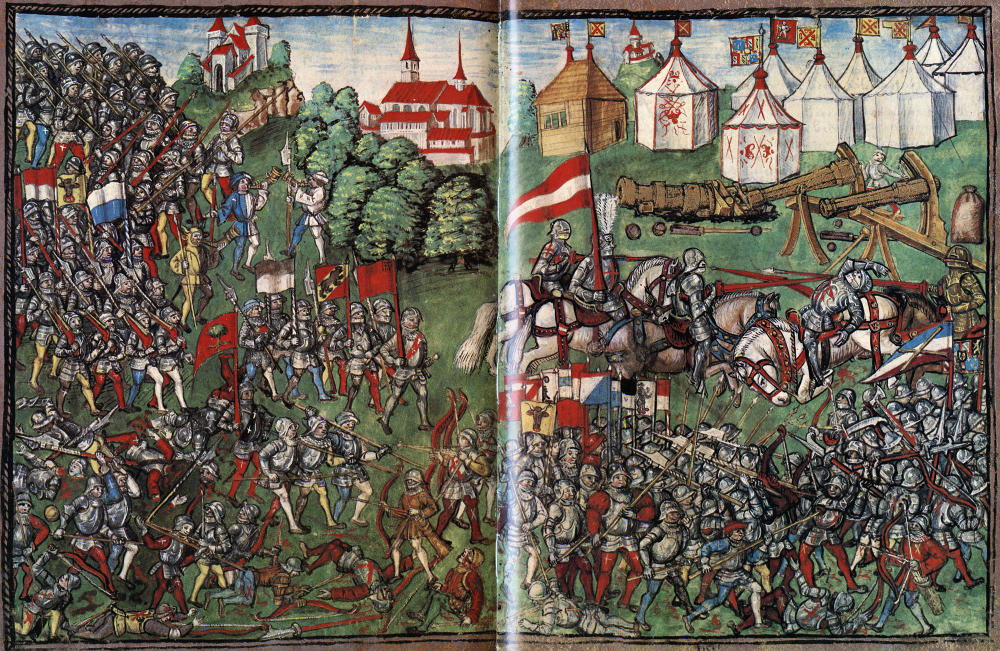
Create an Amazon Business Account
The Battle of Grandson, by Schilling

A larger image of The Battle of Grandson, by Diebold Schilling


A miniature in Diebold Schilling the Younger's 'Lucerne Chronicle' depicting the Battle of Grandson.
Painted c.1512-1515.
An extract from Armies of the Middle Ages, Volume 1 by Ian Heath
GRANDSON, 2 March 1476
The first of Charles the Bold of Burgundy's three disastrous encounters with the Swiss. On this occasion the Burgundians numbered some 15,000 men plus considerable artillery, while the Swiss, advancing downhill towards Grandson with Neuchâtel Lake on their left, comprised in all about 20,000 men, with Berne having supplied the largest contingent (7,343 men).
The action began accidentally, the Swiss advance foraging column and Vorhut of some 2,500 men coming upon the Burgundian vanguard as it was pitching camp. Although the Swiss commanders ordered a halt in order to await their Gewalthut and Nachhut, skirmishing ensued between Schwyz handgunners and the Burgundian archers sent forward by Duke Charles, the latter eventually coming off the worse and withdrawing with some losses. By this time elements of the Swiss Gewalthut had appeared on the scene, bringing Swiss strength up to some 10,000 men, while Charles had now fully deployed his own forces on the plain before them. His plan was to bombard the Swiss formation with his artillery and follow up with cavalry attacks.
The Swiss drew up in their characteristic square with halberdiers and ensigns in the centre surrounded by ranks of pikemen, and a small forlorn hope of 300 crossbow and handgun-armed skirmishers. Their few artillery pieces they positioned on the left flank, these returning several telling volleys when the considerably superior Burgundian ordnance opened fire.
The Burgundian cavalry, including Charles' own guard drawn up in a wedge formation in the second wave, now launched a series of charges which drove back the skirmishers but came to grief on the Swiss wall of pikes, though a fierce hand-to-hand melee took place on the Burgundian left flank where Charles' cavalry wing under Louis de Chalon collided with the right-hand corner of the square whilst attempting to outflank it. Nevertheless, the Swiss continued to repulse the Burgundian cavalry assaults until finally Charles, thinking that the Vorhut was in fact the entire Swiss force, decided to draw their square further into the plain and thereby expose its flanks and rear. He therefore ordered his centre to withdraw slightly and his archers and artillery to transfer to the flanks, also moving his cavalry reserve to the left flank from where he intended to deliver his coup de grace. However, whilst the Burgundians were in the midst of this redeployment the Swiss Gewalthut and Nachhut columns suddenly appeared on the scene, and all 3 divisions now began a steady advance towards the disorganised Burgundians. Chaos ensued as the Burgundian centre, interpreting Charles' carefully planned withdrawal as a sign of defeat, broke in rout and carried the rearguard away with it, so that the duke, left with only his cavalry and artillery, had no option but to retreat in their wake.
With absolutely no cavalry in their ranks, the Swiss were unable to follow up their advantage, contenting themselves instead with the rich booty of the Burgundian camp, and as a result casualties were very light, the Swiss losing only about 200 dead plus a fair number of wounded, the Burgundians suffering only some 1,000 dead (Commynes says only 7 men-at-arms), though they lost their entire artillery park of allegedly some 420 pieces (mostly small calibre guns) and 300 barrels of powder. The Swiss also captured 10,000 pack-horses and 1,500 wagons.